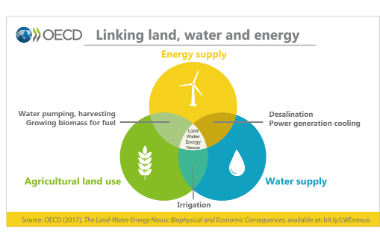Environmental indicators, modelling and outlooks

The Land-Water-Energy Nexus
Biophysical and Economic Consequences
This report contributes to the discussion of interconnections between scarce resources
by highlighting the nexus between land, water and energy (the LWE nexus). It focuses
on a dynamic, integrated, and disaggregated analysis of how land, water and energy
interact in the biophysical and economic systems. The report provides projections
for the biophysical and economic consequences of nexus bottlenecks until 2060, highlighting
that while the LWE nexus is essentially local, there can be significant large-scale
repercussions in vulnerable regions, notably on forest cover and in terms of food
and water security.
The analysis is based on coupling a gridded biophysical systems model with a multi-regional,
multi-sectoral dynamic general equilibrium modelling assessment. Numerical insights
are provided by investigating a carefully selected set of scenarios that are designed
to illustrate the key bottlenecks: one scenario for each resource bottleneck, plus
two scenarios that combine all bottlenecks, with and without an overlay of climate
change.
Published on September 26, 2017
TABLE OF CONTENTS
| Preface | |
| Foreword | |
| Acronyms and abbreviations | |
| Executive summary | |
| The nexus between land, water and energy | |
| A framework for assessing the land-water-energy nexus | |
| Trends that drive the land-water-energy nexus | |
| Biophysical and economic consequences of the nexus bottlenecks | |
| An integrated look at the nexus bottlenecks | |
Powered by OECD iLibrary
